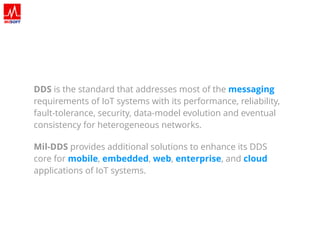DDS-to-JSON and DDS Real-time Data Storage with MongoDB
- 1. DDS-to-JSON and DDS Real-time Data Storage with MongoDB Mil-DDS IoT Suite Abdullah OZTURK,Technical Lead
- 2. ? The world is becoming more and more instrumented, interconnected and intelligent, resulting in newly generated data. ? Among all the types of Big Data, data from sensors is the most widespread and is referred to as time-series data. ? With storage costs coming down signi?cantly, companies now want to leverage this sensor/device generated data for conducting analysis.
- 3. JSON, or JavaScript Object Notation, is an open- standard format for human-readable text. ? It often consists of key-value pairs in a hierarchical structure. ? JSON has become a de facto standard format for exchanging machine-generated data.
- 4. ? Multi-structured data types typical in IoT applications can be modeled more e?ciently using JSON documents, rather than SQL tables. ? JSON is better adapted than XML to devices with limited capabilities such as smart things. ? JSON has become a nice connector to bridge the physical (IoT) and the digital worlds (Web Services).
- 5. ? The ?ood of machine-generated data from IoT is one of the primary drivers behind the accelerating adoption of non- relational systems. ? RDBMS in its natural format was not designed for storing or managing time-series data. ? NoSQL databases are both ?exible and scalable enough to keep pace with the explosion in connected devices. ? JSON is emerging as a preferred format in web-centric, so- called NoSQL databases.
- 6. How DDS Recording Service Works? ? Acquire large volumes of real-time data from sensors and devices with Data Distribution Service (DDS), ? convert to JSON format and, ? store it into a time series document in a MongoDB collection.
- 7. DDS Recording Service ? Recorded data is immediately available for ? replay, ? querying, ? conversion to commonly accepted formats, ? data analysis. ? It becomes useful in project development, testing and system integration as well as in deployed systems. ? Replay can be con?gured ? domain, topics, replay speed and time interval.
- 8. ? MongoDB as a NoSQL database can manage data of any structure, no matter how often it changes. ? New DDS topic types can be added to the system without redesigning the database. ? MongoDB provides high-performance data persistence. ? Robust authentication, authorization, auditing and encryption controls. ? MongoDB can run complex ad-hoc or reporting analytics in-place against sensor data.
- 9. ? MongoDB is built to scale out by its automatic sharding, which distributes data across a cluster of servers, with application transparency. ? Replica sets provide redundancy and high availability, and are the basis for all production deployments.
- 10. DDS is the standard that addresses most of the messaging requirements of IoT systems with its performance, reliability, fault-tolerance, security, data-model evolution and eventual consistency for heterogeneous networks. Mil-DDS provides additional solutions to enhance its DDS core for mobile, embedded, web, enterprise, and cloud applications of IoT systems.
- 11. Thank you. Mil-DDS IoT Suite Abdullah OZTURK,Technical Lead











